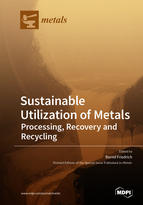Sustainable Utilization of Metals - Processing, Recovery and Recycling
A special issue of Metals (ISSN 2075-4701). This special issue belongs to the section "Extractive Metallurgy".
Deadline for manuscript submissions: closed (30 September 2018) | Viewed by 150873
Special Issue Editor
Interests: pyrometallurgy; process technology; metals; recycling; purification; alloying; WEEE; spent batteries; critical materials; circular economy; electrometallurgy
Special Issues, Collections and Topics in MDPI journals
Special Issue Information
Dear Colleagues,
The high demand on advanced metallic materials raises the need for an extensive recycling of metals and a more sustainable use of raw materials. Advanced materials are crucial for technological applications, coexisting with an increasing scarcity of natural resources. This Special Issue, "Sustainable Utilization of Metals - Processing, Recovery and Recycling", is dedicated to the latest scientific achievements in efficient production of metals, purposing a sustainable resource use.
The idea of a circular economy is the point of origin for contributions, aiming on the recirculation of metal-rich waste streams—such as Waste Electric and Electronic Equipment (WEEE), multi-metal alloys and composite materials—back into metal production. This topic goes along with pursuing the holistic use of input materials, resulting in the avoidance of waste by-products. In order to minimize material losses and energy consumption, this issue explores concepts for the optimization concerning the interface between mechanical and thermal pre-treatment and metallurgical processes.
Furthermore, the direct re-use of complex alloys and composite materials without splitting them up into their single constituents is taken into account.
Papers in this issue are also engaged with the question, how the properties of indispensable advanced materials and alloys can be preserved by a more responsible input or even avoidance of particular constituents. In this regard, new approaches in material design, structural engineering and substitution are provided.
Considering both principal aspects—circular economy and material design—the recovery and the use of minor metals play an essential role, since their importance for technological applications often goes along with a lack of supply on the world market. Additionally, their ignoble character, as well as their low concentration in recycling materials cause a low recycling rate of these metals, awarding them the status of “critical metals”.
Prof. Dr. Bernd Friedrich
Guest Editor
Manuscript Submission Information
Manuscripts should be submitted online at www.mdpi.com by registering and logging in to this website. Once you are registered, click here to go to the submission form. Manuscripts can be submitted until the deadline. All submissions that pass pre-check are peer-reviewed. Accepted papers will be published continuously in the journal (as soon as accepted) and will be listed together on the special issue website. Research articles, review articles as well as short communications are invited. For planned papers, a title and short abstract (about 100 words) can be sent to the Editorial Office for announcement on this website.
Submitted manuscripts should not have been published previously, nor be under consideration for publication elsewhere (except conference proceedings papers). All manuscripts are thoroughly refereed through a single-blind peer-review process. A guide for authors and other relevant information for submission of manuscripts is available on the Instructions for Authors page. Metals is an international peer-reviewed open access monthly journal published by MDPI.
Please visit the Instructions for Authors page before submitting a manuscript. The Article Processing Charge (APC) for publication in this open access journal is 2600 CHF (Swiss Francs). Submitted papers should be well formatted and use good English. Authors may use MDPI's English editing service prior to publication or during author revisions.
Keywords
- recycling
- circular economy
- zero waste
- material design and substitution
- critical metals






